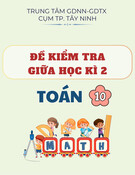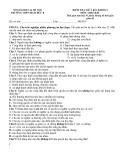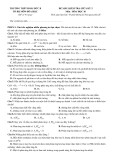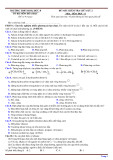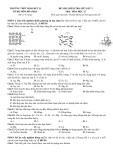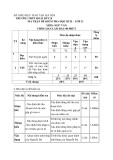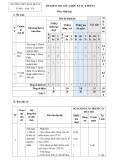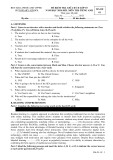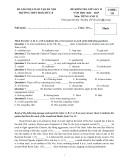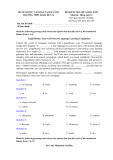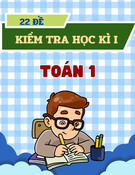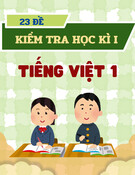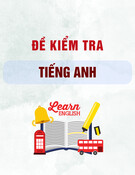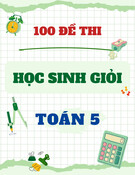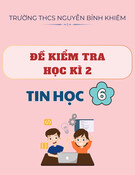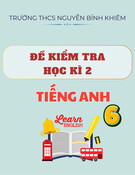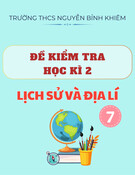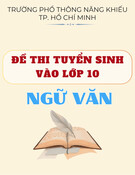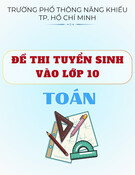SỞ GIÁO DỤC ĐÀO TẠO QUẢNG NAM MA TRẬN ĐỀ KIỂM TRA HỌC KỲ 2-NĂM HỌC 2022-2023
TRƯỜNG THPT TRẦN ĐẠI NGHĨA Môn: Tiếng Anh – Khối 11(7 năm)
Thời gian: 45 phút (không kể thời gian phát đề)
LEVELS
Notes
Knowledge
Understanding
Application
Tested Contents
Listening
4 câu
2 câu
4 câu
Unit 10,11, 13,15
8 câu
1 câu
1 câu
High Application
Vocabulary and Grammar Reading
3 câu
4 câu
3 câu
Writing
1 câu
2 câu
2câu
Tổng
16 câu
11 câu
6 câu
Unit 9,10,11,12,13,15 Cloze test Reading and comprehension reading Relative clauses Cleft sentence
2 câu
SỞ GIÁO DỤC ĐÀO TẠO QUẢNG NAM MA TRẬN ĐẶC TẢ ĐỀ KIỂM TRA HỌC KỲ 2
TRƯỜNG THPT TRẦN ĐẠI NGHĨA NĂM HỌC 2022-2023
Môn: Tiếng Anh – Khối 11(7 năm)
Thời gian: 45 phút (không kể thời gian phát đề)
Questions
Tested Contents
LEVELS Knowledge Understand
Application
Notes
High Application
1
X
ing
True- False (Listening)
2
X
Level A1-A2/ Topics related to Units 12
3
X
4
X
5
X
6
X
Multiple Choice (Listening)
7
X
8
X
9
X
10
X
11
Phonetic
X
/sk /
12
Phonetic
X
/sl/
13
vocabulary
x
synonym
14
Grammar
X
Omit relative pronoun
15
Vocabulary
X
Word meaning
16
Grammar
X
Cleft sentence
17
Grammar
X
Relative pronoun
18
vocabulary
X
preposition
19
vocabulary
x
Word meaning
x
Tag- question
20
Grammar
preposition
21
X
x
Conjunction
22
x
Word meaning
23
X
Word meaning
24
X
Word meaning
25
x
26
Cloze Text (Level A2) Reading comprehension (Level A2)
x
27
X
28
Reference (Vocabulary)Main idea/ Inference Reference (Vocabulary)Main idea/ Inference Reference (Vocabulary Getting details Getting details
29
x
x
30
X
1
x
Reference (Vocabulary Getting details Relative pronoun with preposition Relative pronoun
2
Transformation writing
x
Relative clause
3
x
Cleft sentence
4
x
5
Writing combination
Combine and reduce relative pronoun
Notes: Questions 1- 30: 6 đ (0,2 pts/ sentence) Writing Questions 1- 5: 2đ (0,4pts/sentence)
Speaking: 2 đ
SỞ GD & ĐT QUẢNG NAM ĐỀ KIỂM TRA GIỮA KỲ 2- NĂM HỌC 2022-2023
TRƯỜNG THPT TRẦN ĐẠI NGHĨA MÔN: TIẾNG ANH – KHỐI 11 ( 7 NĂM)
Thời gian : 45 phút ( không kể thời gian phát đề)
ĐỀ GỐC 1 ( Đề có 04 trang)
LISTENING:
Part 1: You will hear a talk about the first human moon landing, one of the most important historical events in the 20th century. Listen to the talk and decide whether the statements are true (T) or false (F).
1. There were 11 astronauts on board the spacecraft to the moon .
B. F A. T
2. NASA's Apollo program was developed to meet President Kennedy's challenge.
A. T B. F
3. The Apollo 11 launched on July 16th, 1969.
A. T B. F
4. Neil Armstrong became the first man on the moon on July 20th, 1968.
A. T B. F
5. The astronauts landed on the moon at the same time.
A. T B. F
Part 2: You will hear again then do the task follow.
6. The Apollo 11 was ___________ into space on July 16th, 1969.
A. launched B. taken C. gone D. lifted
7. The astronauts stayed on the surface of the moon for _______ hours.
A. two and half B. two C. half an D. many
8. The portable life support system was used for controlling ____________ inside the spacesuit.
A. the oxygen and pressure B. temperature and pressure
C. the oxygen, temperature and pressure D. None is correct.
9. The second man to set foot on the moon was ___________ .
A. Michael Collins. B. Neil Armstrong
C. Buzz Aldrin and Michael Collins. D. Buzz Aldrin
10. The astronauts return to the Earth ____________ .
A. on June 24th , 1969 B. on July 24th, 1969.
C. on July 14th , 1968 D. On July 24th , 1968
B. schilling B. asleep D. scholar D. islander C. ski C. slice
MULTIPLE CHOICE TEST Mark the letter A, B, C, or D on your answer sheet to indicate the word whose underlined part differs from the other three in pronunciation in each of the following questions. Question 11: A. skill Question 12: A. slow Mark the letter A, B, C or D on your answer sheet to indicate the word CLOSEST in meaning to the underlined word in the following question. Question 13: Norman won the first prize in the cookery competition.
A. contest B. occasion C. course D. organization
A. I used to live in it C. who I used to live in it B. I used to live in D. whom I used to live in it Mark the letter A, B, C or D on your answer sheet to indicate the correct answer to each of the following questions. Question 14: That’s the house _____________ . Question 15: There are some hobbies that I ……… in for a while besides reading and collecting.
A. occupy B. accomplish C. fascinate D. indulge
Question 16: ___________ takes me to the circus.
A. It is Peter that B. was that Peter C. was it Peter that D. It was Peter that
Question 17: The fans ________ crowded the stadium roared their approval
A. who B. which C. whose D. what
Question 18: The Sun releases large amount _________ energy everyday.
A. for B. in C. for D. of
Question 19: I had forgotten all about it because I had been so ____ with other things.
A. occupied B. interested C. accomplished D. successful
Question 20: No salt is needed,___?
A. is it B. isn’t it C. did it D. didn’t it
READING A- Choose the item among A,B,C or D that best answers the question about the passage
Millions of people of all ages enjoy a hobby which is both interesting and fun. And every
year, more and more people start a stamp collection (21)……..their own and discover an interest which can last a lifetime. Starting your collection is easy (22)…….stamps can be found everywhere. Holiday postcards from friends, birthday cards from relatives and letters from pen pals can all (23)………you with stamps from all over the world. But once you have started collecting (24)………, you will probably want to join the Stamp Collectors’ Club which (25)…….to provide collectors with new British stamps.
B. for C. from D. on 21. A. of
22. A. moreover B. because C. furthermore D. addition
23. A. export B. provide C. consider D. take
24. A. attractive B. competitive C. great D. seriously
25. A. own B. survive C. exists D. live
B- Read the passage and answer the questions that follow by circling the corresponding letter A,B,C, or D.
World Wildlife Fund (WWF) safeguards hundreds of species around the world, but we focus species attention on our flagship species: giant pandas, tigers, endangered whales and dolphins, rhinos, elephant, marine turtles and great apes. These species not only need species measures and extra protection in order to survive, they also serve as “umbrella” species: helping them helps numerous other species that live in the same habitats where animals or plants are normally found. In addition to our flagship animals, we work to protect numerous species in peril around the world that live within our priority eco-regions. Laree predators like snow leopards and grizzly bears, migratory species like whooping cranes and songbirds, and a host of other species facing threats also benefit from WWF’ s conservation efforts. Our wildlife trade experts at “traffic” work to ensure that trade wildlife products, doesn’t harm a species, while also fighting against illegal and unsustainable trade. WWF is known for acting sound science. Science leads and guides us strategies and approaches, from the way to restore tigers in viable, breed population to decide which areas need protection the most.
26. What does WWF stand for?
A. World Wildlife Fund. B. World Wildlife Food.
C. World Wildlife Formation. D. World Website Fund.
27. How many species do we pay much attention to?
A. 8 B. 5 C. 7 D. 9
28. What is the meaning of the world habitats in paragraph 1?
A. The place where animals or plants are normally found. B. The place where animals or plants can drink and sleep
C. The place where animals or plants can eat find their enemy. D. The place where animals can find and keep their body warm.
29. What can science help us in safeguarding endangered species?
A. Lead and guide strategies and approaches. B. Find the way to kill all species easily.
C. Discover another habitat of animal. D. Search for a food source for animals.
30. Which of the following is not stated in the passage?
A. WWF safeguards hundreds of species around the world.
B. These above species need extra protection so as not to be extinct.
C. WWF is known for acting on sound science.
D. All species are so fierce that scientists can’t take care of them.
WRITING
finish each sentence as instructed in such a way that it means the same as the sentence printed before it.
Question 1. My mother teaches at the school which is in the center of the city.
(Use a relative pronoun with a preposition)
→ The school at which my mother teaches is in the center of the city.
Question 2. The wall surrounding our house is made of bricks.
→ The wall which surrounds our house is made of bricks.
Combine each pair of sentences into one as directed.
Question 3. That man did not know what to do. His mobile was ringing. (Use: whose) → That man whose mobile was ringing did not know what to do.
Question 4 . The thick fog prevented me from going to work. ( use cleft sentence) → It was the thick fog that prevented me from going to work.
Question 5. He was the first student. He gave the best answer to the question. (combine the sentences using an infinitive phrase) → He was the first student to give the best answer to the question.
SỞ GD & ĐT QUẢNG NAM ĐỀ KIỂM TRA GIỮA KỲ 2- NĂM HỌC 2022-2023
TRƯỜNG THPT TRẦN ĐẠI NGHĨA MÔN: TIẾNG ANH – KHỐI 11 ( 7 NĂM)
Thời gian : 45 phút ( không kể thời gian phát đề)
ĐỀ GỐC 2 ( Đề có 04 trang)
________________________________________________________________________________
LISTENING:
Part 1: You will hear a talk about the first human moon landing, one of the most important historical events in the 20th century. Listen to the talk and do the task follow.
1. The Apollo 11 was ___________ into space on July 16th, 1969.
A. launched B. taken C. gone D. lifted
2. The astronauts stayed on the surface of the moon for _______ hours.
A. two and half B. two C. half an D. many
3. The portable life support system was used for controlling _______________________ inside the spacesuit.
A. the oxygen and pressure B. temperature and pressure
C. the oxygen, temperature and pressure D. None is correct.
4. The second man to set foot on the moon was ___________ .
A. Michael Collins. B. Neil Armstrong
C. Buzz Aldrin and Michael Collins. D. Buzz Aldrin
5. The astronauts return to the Earth ____________ .
B. on July 24th, 1969. A. on June 24th , 1969
C. on July 14th , 1968 D. On July 24th , 1968
Part 2: You will hear a talk about the first human moon landing, one of the most important historical events in the 20th century. Listen to the talk and decide whether the statements are true (T) or false (F).
6.There were 11 astronauts on board the spacecraft to the moon .
A. T B. F
7. NASA's Apollo program was developed to meet President Kennedy's challenge.
A. T B. F
8. The Apollo 11 launched on July 16th, 1969.
A. T B. F
9. Neil Armstrong became the first man on the moon on July 20th, 1968.
A. T B. F
10. The astronauts landed on the moon at the same time.
A. T B. F
MULTIPLE CHOICE TEST (6 points) Mark the letter A, B, C, or D on your answer sheet to indicate the word whose underlined part differs from the other three in pronunciation in each of the following questions.
Question 1: A schooling B. skim C. schappe D. skull
Question 2: A. island B. slave C. slim D. sleeping
Mark the letter A, B, C or D on your answer sheet to indicate the word CLOSEST in meaning to the underlined word in the following question.
Question 3: Yuri Gagarin lifted off into space aboard the Vostok 1
A. attracted B. occurred C. reacted D. launched
Mark the letter A, B, C or D on your answer sheet to indicate the correct answer to each of the following questions.
A. the company has just hired C. the company has just hired her Question 4:The new employee ______________ has got an MBA at a foreign university. B. where the company has just hired her D. which the company has just hired her Question 5: Gagarin was a 27 year-old Soviet …………….
B. venture C. spaceship D. gravity A. cosmonaut
Question 6: . __________ that Columbus sailed to America.
A. In 1492 B. It was in 1492 C. That was in 1492 D. It is in 1492
Question 7: Mr. Dan, __________ is now teaching us English, has written several books.
A. who B. whom C. which D. that
Question 8: Yuri Gagarin became the first man to travel into space ____ April 12th, 1961.
A. at B. on C. in D. from
Question 9: The …………. of Gagarin’s flight attracted worldwide attention and made him a hero
D. success A. successful B. succeed C. successfully
Question 10: You used to live on the farm during your childhood, ?
A. weren’t you B. didn’t you C. don’t you D. aren’t you
READING Read the following passage and mark the letter A, B, C, or D on your answer sheet to indicate the correct word or phrase that best fits each of the numbers blanks.
The number of animal species that have die out since 1960 _____(11 ) sharply. Experts have
looked for historical evidence of extinction. As far as they can tell, between modern historical records and the beginning of the 17th century, fewer ______(12) 20 species of animals died out. _______( 13) , in just one century, from 1600 to 1699, seven more animals species are known to have _______(14 ) . The next century saw the extinction of 36 species. And the rate kept _________ (15). In the first three quarters of the 20th century, 83 species disappeared, despite the education of people about endangered species. The rate of extinction has not been slowed by public information.
C. has increased D. will increased Question 11: A. increase B. increased
Question 12: A. as B. more C. less D. than
Question 13: A. If B. although C. so D. however
Question 14: A. recovered B. supplied C. changed D. disappeared
Question 15: A. increasing B. to increase C. being increased D. to be increased
B- Read the passage and answer the questions from 36 to 40 that follow by circling the corresponding letter A,B,C, or D.
World Wildlife Fund (WWF) safeguards hundreds of species around the world, but we focus species attention on our flagship species: giant pandas, tigers, endangered whales and dolphins, rhinos, elephant, marine turtles and great apes. These species not only need species measures and extra protection in order to survive, they also serve as “umbrella” species: helping them helps numerous other species that live in the same habitats where animals or plants are normally found. In addition to our flagship animals, we work to protect numerous species in peril around the world that live within our priority eco-regions. Laree predators like snow leopards and grizzly bears, migratory species like whooping cranes and songbirds, and a host of other species facing threats also benefit from WWF’ s conservation efforts. Our wildlife trade experts at “traffic” work to ensure that trade wildlife products, doesn’t harm a species, while also fighting against illegal and unsustainable trade. WWF is known for acting sound science. Science leads and guides us strategies and approaches, from the way to restore tigers in viable, breed population to decide which areas need protection the most.
36. What does WWF stand for?
B. World Wildlife Food. C. World Wildlife Formation. D. World
A. World Wildlife Fund. Website Fund.
37. How many species do we pay much attention to?
A. 8 B. 5 C. 7 D. 9
38. What is the meaning of the world habitats in paragraph 1?
A. The place where animals or plants are normally found. B. The place where animals or plants can drink and sleep
C. The place where animals or plants can eat find their enemy. D. The place where animals can find and keep their body warm.
39. What can science help us in safeguarding endangered species?
B. Find the way to kill all species
A. Lead and guide strategies and approaches. easily.
C. Discover another habitat of animal. D. Search for a food source for animals.
40. Which of the following is not stated in the passage?
A. WWF safeguards hundreds of species around the world. B. These above species need extra protection so as not to be extinct. C. WWF is known for acting on sound science. D. All species are so fierce that scientists can’t take care of them.
WRITING
Combine each pair of sentences into one as directed.
Question 1: The man called the police. His wallet was stolen. (Use “whose”)
→ The man whose wallet was stolen called the police.
Question2: Lan’s mother got angry with her. (using Cleft sentence ) → It was Lan’s mother that / who got angry with her.
Question 3: Neil Armstrong was the first man . He landed on the moon . (combine the sentences using an infinitive phrase) → Neil Armstrong was the first man to land on the moon .
Finish each sentence as instructed in such a way that it means the same as the sentence printed before it.
Question 4. The apartment overlooking the park is more expensive than this one. →The apartment which overlooks the park is more expensive than this one. Question 5. We are ling in the flat which was surrounded by trees.(Use a relative pronoun with a
preposition)
→ The flat in which we are living was surrounded by trees.
THE END.


